Mary Lydon Simonsen's Blog: What readers are saying about The Second Date, page 3
November 17, 2013
Darcy on the Hudson - Research and Background #3 - Thanksgiving
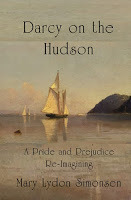 During the Federal Era in America, a time corresponding to the Regency Era in England, the biggest holiday of the year was Thanksgiving. At that time, more Americans lived on farms than in cities, and with the grain harvested, the fruit preserved, and the pig butchered, it was time to join with family and friends to celebrate with prayer, song, and dancing the gifts of the harvest.
During the Federal Era in America, a time corresponding to the Regency Era in England, the biggest holiday of the year was Thanksgiving. At that time, more Americans lived on farms than in cities, and with the grain harvested, the fruit preserved, and the pig butchered, it was time to join with family and friends to celebrate with prayer, song, and dancing the gifts of the harvest.In 1834, the New Hampshire Patriot made note of the approaching holiday: A moderate rise in the price of molasses and spices—the increased demand for laces, ribbons, and dancing pumps—the hurrying of tailors, milliners, and mantua makers—frequent and important consultation of young gentlemen—whispering, flushed faces, and anxious looks among young ladies—and lastly, a string of proclamations announcing the 27th of November as a day of Thanksgiving in New Hampshire, Massachusetts, Connecticut, and Vermont.”*
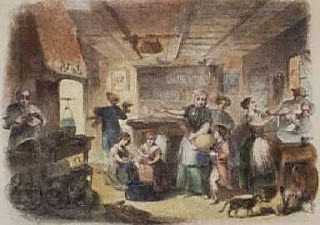 Preparations for the feastIn my novel,
Darcy on the Hudson
, Fitzwilliam Darcy, Georgiana, and Charles Bingley travel to Tarrytown in the Hudson River Valley to visit Bingley’s Uncle Richard, who has been living in America for twenty-five years. In addition to the love story of Darcy and Elizabeth, the novel mentions the Thanksgiving traditions of the New York/New England area. Here are three excerpts:
Preparations for the feastIn my novel,
Darcy on the Hudson
, Fitzwilliam Darcy, Georgiana, and Charles Bingley travel to Tarrytown in the Hudson River Valley to visit Bingley’s Uncle Richard, who has been living in America for twenty-five years. In addition to the love story of Darcy and Elizabeth, the novel mentions the Thanksgiving traditions of the New York/New England area. Here are three excerpts:First, advanced preparations for the big day: “While sloops sailed north from the port of New York carrying Jamaica Rum, French and cider brandy, molasses, loaf and brown sugars, Hyson-Souchong and Bohea teas, various spices, dried fruits, coffee, and chocolate, barges filled to overflowing with cages containing live poultry and suckling pigs were arriving from Upstate New York at Tarrytown Harbor.” [image error]
Second, the preparation for the feast: “In the Bennet kitchen, Mrs. Kraft, Mrs. MacTavish, and Mrs. Wesley were already busy baking pies with every possible fruit filling, as well as Marlborough pies, brimming with apple and lemon custard. The five Bennet daughters, and every female servant at Longbourn, were either assisting in baking something or at Mrs. Bennet’s beck and call, running back and forth from the pantry cupboard, spring house, or woodpile bringing needed ingredients to the bakers or kindling to those tending the fires.”
Finally, the big day arrives: “After Mr. Bennet had finished saying grace and reading his proclamation, he began to carve the turkey, and everyone waited in anticipation as the bird was dismembered and the first slices fell onto the meat platter. Plates were heaped with potatoes, sweet potatoes, plum pudding, and vegetables, and everyone was encouraged to gorge themselves. The second course of cheese, squash pies, grapes, jellies, dried fruits, and nuts was eaten with relish, and everyone admitted that a break was necessary before enjoying the desserts.”
After the guests found the energy to push their chairs away from the table, they adjourned to the parlor for games and dancing. It was an excellent opportunity for young men and women to flirt or to begin a courtship. With family and friends gathered together on this special day, many chose that date as their wedding day. What better day could the happy couple have chosen than a day filled with food, drink, song, dance, and good company!
It wasn’t until the middle of the 19thcentury that Christmas would supplant Thanksgiving as the biggest holiday in America.
*Our Own Snug Fireside, Images of the New England Home 1760-1860 by Jane C. Nylander, Yale University Press, p. 264.
Darcy on the Hudson is available at Amazon and Barnes and Noble.
Published on November 17, 2013 23:05
November 14, 2013
Darcy on the Hudson - Research and Background #2 - Boscobel Manor House
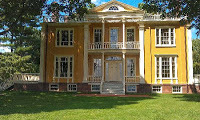
The Bennet family home was modeled on Boscobel (pretty woodlands) now located in Garrison, New York overlooking the Hudson River. It was built in the early 19th century by States Dyckman and is an outstanding example of the Federal style of American architecture. Boscobel's distinguishing feature is the unusual delicacy conveyed by the front facade and its ornamentation.
From Wikipedia: “Dyckman, a descendant of early Dutch settlers of Manhattan, had managed to retain his family fortune despite being an activeLoyalist... In 1794, he married Elizabeth Corne, daughter of another Loyalist family, who was twenty-one years his junior. After three years in London, Dyckman returned to the United States in 1803 and set about building the house he had long planned. Dyckman died in 1806 before it was finished. His widow completed it, and she and their surviving son moved into it in 1808. It would stay in the family until 1920.
"For the next 35 years, under subsequent owners, it frequently faced the possibility of being demolished. In 1955 an organization called Friends of Boscobel saved it at the last minute from a contractor who had bid $35 to knock it down after the Veterans’ Administration had built a hospital on the site. They arranged for it to be moved to a similar location upriver near Garrison, New York. Lila Acheson Wallace, wife of Reader’s Digest founder DeWitt Wallace provided the $50,000 or the move and reconstruction.”
 Moving Boscobel to its new location
Moving Boscobel to its new locationboscobel.org
During restoration, every salvageable piece was numbered and then moved to the new site in Garrison in 1957. The rebuilt home was formally reopened on May 21, 1961. In the late 1970s, new papers of Dyckman's were discovered, and the house was closed for six months in 1977 while it was redecorated in a manner more consistent with his recorded tastes.”
Distinguishing features:
The entry hall - As the largest room in the house, it served several purposes. This is where guests would be received and was the site of cotillions and musicales. The triple arch separated the public and private areas.
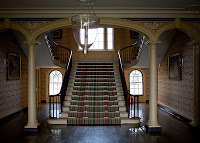 Entryway - boscobel.orgAfter admiring displays of fine porcelains, the company returned to the magnificent entry hall, the largest room in the house, with its faux marble wallpaper, triple arch, and grand staircase lit by a rose window on the landing. In addition to serving as a place to welcome visitors, it was used for dancing, musicales, charades, plays, and card games.The remainder of the evening was divided between dancing to tunes played by Miss Darcy and the four favorites that could be played on the barrel organ. Mr. and Mrs. Bennet joined the young dancers, and at the end of the evening, Mary was coaxed on to the dance floor by Georgiana. (p. 40)
Entryway - boscobel.orgAfter admiring displays of fine porcelains, the company returned to the magnificent entry hall, the largest room in the house, with its faux marble wallpaper, triple arch, and grand staircase lit by a rose window on the landing. In addition to serving as a place to welcome visitors, it was used for dancing, musicales, charades, plays, and card games.The remainder of the evening was divided between dancing to tunes played by Miss Darcy and the four favorites that could be played on the barrel organ. Mr. and Mrs. Bennet joined the young dancers, and at the end of the evening, Mary was coaxed on to the dance floor by Georgiana. (p. 40)Drawing rooms – The front drawing room featured Duncan Phyfe furniture and was modeled on the Robert Adam interiors then so popular in England. The rear drawing room contains a 1796 English model barrel organ that could play four tunes.
In the front parlor, Mr. Bennet asked Charles what he thought of the carved fireplace that reminded Darcy of the Adam’s fireplaces at Pemberley with their detailed fretwork and neoclassical embellishments...“It is finely carved, sir. May I ask what wood was used?”“You may, Charles, but I will tell you that no wood was used. It is plaster painted to look like wood, and made at a manufactory I own on the west side of the river. It costs a fraction of what is required for marble. With a growing shortage of wood here in the lower valley, finding an alternative was a necessity.” (p. 40)
Dining room – The dining room chairs are made of maple painted to look like bamboo, thus introducing an Eastern influence into the room.
 Dining Room - From boscobel.orgIn the dining room, Darcy noted the fine furnishings and service, including a lovely set of Serves porcelain china, with each plate and bowl individually painted with a different scene of the French countryside. There were cut glass candelabra and a fireplace with plasterwork on the mantle depicting a Roman chariot race that he admired. All in all, it was an impressive room. (p. 80)
Dining Room - From boscobel.orgIn the dining room, Darcy noted the fine furnishings and service, including a lovely set of Serves porcelain china, with each plate and bowl individually painted with a different scene of the French countryside. There were cut glass candelabra and a fireplace with plasterwork on the mantle depicting a Roman chariot race that he admired. All in all, it was an impressive room. (p. 80)Kitchen – The kitchen includes a primitive rotisserie where meats would be “done to a turn.” (p. 80)
In the Bennet kitchen, Mrs. Kraft, Mrs. MacTavish, and Mrs. Wesley were busy baking pies with every possible fruit filling, including Marlborough pies, brimming with apple and lemon custard [for Thanksgiving]. The five Bennet daughters and all the help were either assisting in the baking or at Mrs. Bennet’s beck and call running back and forth from the pantry cupboard, springhouse, or woodpile bringing needed ingredients to the bakers or kindling to those tending the fires. (p. 226)
Boscobel is one of the glories of the Hudson River Valley. You can learn more by visiting their blog.
Published on November 14, 2013 23:05
Darcy on the Hudson - Research and Background #2

The Bennet family home was modeled on Boscobel (pretty woodlands) now located in Garrison, New York overlooking the Hudson River. It was built in the early 19th century by States Dyckman and is an outstanding example of the Federal style of American architecture. Boscobel's distinguishing feature is the unusual delicacy conveyed by the front facade and its ornamentation.
From Wikipedia: “Dyckman, a descendant of early Dutch settlers of Manhattan, had managed to retain his family fortune despite being an activeLoyalist... In 1794, he married Elizabeth Corne, daughter of another Loyalist family, who was twenty-one years his junior. After three years in London, Dyckman returned to the United States in 1803 and set about building the house he had long planned. Dyckman died in 1806 before it was finished. His widow completed it, and she and their surviving son moved into it in 1808. It would stay in the family until 1920.
"For the next 35 years, under subsequent owners, it frequently faced the possibility of being demolished. In 1955 an organization called Friends of Boscobel saved it at the last minute from a contractor who had bid $35 to knock it down after the Veterans’ Administration had built a hospital on the site. They arranged for it to be moved to a similar location upriver near Garrison, New York. Lila Acheson Wallace, wife of Reader’s Digest founder DeWitt Wallace provided the $50,000 or the move and reconstruction.”
 Moving Boscobel to its new location
Moving Boscobel to its new locationboscobel.org
During restoration, every salvageable piece was numbered and then moved to the new site in Garrison in 1957. The rebuilt home was formally reopened on May 21, 1961. In the late 1970s, new papers of Dyckman's were discovered, and the house was closed for six months in 1977 while it was redecorated in a manner more consistent with his recorded tastes.”
Distinguishing features:
The entry hall - As the largest room in the house, it served several purposes. This is where guests would be received and was the site of cotillions and musicales. The triple arch separated the public and private areas.
 Entryway - boscobel.orgAfter admiring displays of fine porcelains, the company returned to the magnificent entry hall, the largest room in the house, with its faux marble wallpaper, triple arch, and grand staircase lit by a rose window on the landing. In addition to serving as a place to welcome visitors, it was used for dancing, musicales, charades, plays, and card games.The remainder of the evening was divided between dancing to tunes played by Miss Darcy and the four favorites that could be played on the barrel organ. Mr. and Mrs. Bennet joined the young dancers, and at the end of the evening, Mary was coaxed on to the dance floor by Georgiana. (p. 40)
Entryway - boscobel.orgAfter admiring displays of fine porcelains, the company returned to the magnificent entry hall, the largest room in the house, with its faux marble wallpaper, triple arch, and grand staircase lit by a rose window on the landing. In addition to serving as a place to welcome visitors, it was used for dancing, musicales, charades, plays, and card games.The remainder of the evening was divided between dancing to tunes played by Miss Darcy and the four favorites that could be played on the barrel organ. Mr. and Mrs. Bennet joined the young dancers, and at the end of the evening, Mary was coaxed on to the dance floor by Georgiana. (p. 40)Drawing rooms – The front drawing room featured Duncan Phyfe furniture and was modeled on the Robert Adam interiors then so popular in England. The rear drawing room contains a 1796 English model barrel organ that could play four tunes.
In the front parlor, Mr. Bennet asked Charles what he thought of the carved fireplace that reminded Darcy of the Adam’s fireplaces at Pemberley with their detailed fretwork and neoclassical embellishments...“It is finely carved, sir. May I ask what wood was used?”“You may, Charles, but I will tell you that no wood was used. It is plaster painted to look like wood, and made at a manufactory I own on the west side of the river. It costs a fraction of what is required for marble. With a growing shortage of wood here in the lower valley, finding an alternative was a necessity.” (p. 40)
Dining room – The dining room chairs are made of maple painted to look like bamboo, thus introducing an Eastern influence into the room.
 Dining Room - From boscobel.orgIn the dining room, Darcy noted the fine furnishings and service, including a lovely set of Serves porcelain china, with each plate and bowl individually painted with a different scene of the French countryside. There were cut glass candelabra and a fireplace with plasterwork on the mantle depicting a Roman chariot race that he admired. All in all, it was an impressive room. (p. 80)
Dining Room - From boscobel.orgIn the dining room, Darcy noted the fine furnishings and service, including a lovely set of Serves porcelain china, with each plate and bowl individually painted with a different scene of the French countryside. There were cut glass candelabra and a fireplace with plasterwork on the mantle depicting a Roman chariot race that he admired. All in all, it was an impressive room. (p. 80)Kitchen – The kitchen includes a primitive rotisserie where meats would be “done to a turn.” (p. 80)
In the Bennet kitchen, Mrs. Kraft, Mrs. MacTavish, and Mrs. Wesley were busy baking pies with every possible fruit filling, including Marlborough pies, brimming with apple and lemon custard [for Thanksgiving]. The five Bennet daughters and all the help were either assisting in the baking or at Mrs. Bennet’s beck and call running back and forth from the pantry cupboard, springhouse, or woodpile bringing needed ingredients to the bakers or kindling to those tending the fires. (p. 226)
Boscobel is one of the glories of the Hudson River Valley. You can learn more by visiting their blog.
Published on November 14, 2013 23:05
November 13, 2013
Darcy on the Hudson - Research and Background - Dutch Colonial Architecture
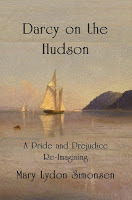 When it gets to be this time of year, I think about the visit my husband and I made to the Hudson River Valley in the spring of 2010. The purpose of the trip was to conduct research for my book,
Darcy on the Hudson
, which is set in the months leading up to the War of 1812. Although I had read tons of books on the American Revolution and the Federal period that followed, there is nothing like being on-site. I thought I would share some of my findings with you.
When it gets to be this time of year, I think about the visit my husband and I made to the Hudson River Valley in the spring of 2010. The purpose of the trip was to conduct research for my book,
Darcy on the Hudson
, which is set in the months leading up to the War of 1812. Although I had read tons of books on the American Revolution and the Federal period that followed, there is nothing like being on-site. I thought I would share some of my findings with you. When Mr. Darcy, Mr. Bingley, and Georgiana Darcy arrive in New York in 1812, they stay with Mr. Bingley’s Uncle Richard who was leasing a Dutch colonial house from his neighbor, Mr. Bennet, in Tarrytown. (Think Sleepy Hollow.) From Darcy on the Hudson:
Richard Bingley’s house was typical of colonial Dutch architecture in that there were no hallways, and a person must pass through one room to gain entry to another. A narrow staircase led to three rooms above, and for purposes of privacy, Georgiana was given the smallest room farthest from the stairs. Darcy and Mercer would be in the room next to Georgiana, and Charles would occupy the largest room, but also the noisiest, because of its location next to the stairs. But Georgiana would soon discover that there was an exterior staircase leading to a porch that wrapped around three sides of the house, a novelty the seventeen-year-old found delightful.
What did a house in the Dutch colonial style look like? According to the website, Life 123, most included the following features:
The door is almost always centered on the house - Cut horizontally, the bisected door allowed the top and bottom half to open separately if required. This enabled the flow of fresh air into the house while keeping domestic animals outside. It also allowed the owners of the house to keep the riff raff out. The missus could talk with visitors without the necessity of inviting them into the house.
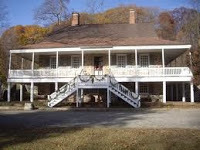 Van Cordlandt Manor
Van Cordlandt ManorGambrel roofs are common - Long, sloping roofs overhang the doorway giving the appearance of a one-story home. Why? Gambrel roofs were said to have saved the Dutch from heavy taxes imposed on two-story homeowners. The Dutch were known for their thrift.
Two chimneys- Unlike classic Colonial homes with the fireplace in the center of the house, Dutch colonial homes had a chimney on each end of the house to radiate warmth.
Stone or brick exteriors - The Dutch were know for their stone and brickwork and brought their talents to the New World.
Porches – They provided shade.
Double-hung sash windows with wooden casements – They provided increased air circulation and allowed hot air to escape in the summer.
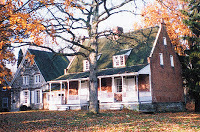 Pieter Bronck HouseIn Darcy on the Hudson, the Bingley house was modeled on Van Cortlandt Manor in Croton-on-Hudson, New York. Research on the traditions of Colonial Dutch New York was conducted at the Pieter Bronck House in Coxsachie, New York.
Pieter Bronck HouseIn Darcy on the Hudson, the Bingley house was modeled on Van Cortlandt Manor in Croton-on-Hudson, New York. Research on the traditions of Colonial Dutch New York was conducted at the Pieter Bronck House in Coxsachie, New York.Next post: Boscobel, the home of the Bennets.
I am scheduled for a blog post on Austen Authors on November 21st, at which time, I will be giving away a copy of Darcy on the Hudson. More about that in later posts.
Published on November 13, 2013 15:30
Darcy on the Hudson - Research and Background
 When it gets to be this time of year, I think about the visit my husband and I made to the Hudson River Valley in the spring of 2010. The purpose of the trip was to conduct research for my book,
Darcy on the Hudson
, which is set in the months leading up to the War of 1812. Although I had read tons of books on the American Revolution and the Federal period that followed, there is nothing like being on-site. I thought I would share some of my findings with you.
When it gets to be this time of year, I think about the visit my husband and I made to the Hudson River Valley in the spring of 2010. The purpose of the trip was to conduct research for my book,
Darcy on the Hudson
, which is set in the months leading up to the War of 1812. Although I had read tons of books on the American Revolution and the Federal period that followed, there is nothing like being on-site. I thought I would share some of my findings with you. When Mr. Darcy, Mr. Bingley, and Georgiana Darcy arrive in New York in 1812, they stay with Mr. Bingley’s Uncle Richard who was leasing a Dutch colonial house from his neighbor, Mr. Bennet, in Tarrytown. (Think Sleepy Hollow.) From Darcy on the Hudson:
Richard Bingley’s house was typical of colonial Dutch architecture in that there were no hallways, and a person must pass through one room to gain entry to another. A narrow staircase led to three rooms above, and for purposes of privacy, Georgiana was given the smallest room farthest from the stairs. Darcy and Mercer would be in the room next to Georgiana, and Charles would occupy the largest room, but also the noisiest, because of its location next to the stairs. But Georgiana would soon discover that there was an exterior staircase leading to a porch that wrapped around three sides of the house, a novelty the seventeen-year-old found delightful.
What did a house in the Dutch colonial style look like? According to the website, Life 123, most included the following features:
The door is almost always centered on the house - Cut horizontally, the bisected door allowed the top and bottom half to open separately if required. This enabled the flow of fresh air into the house while keeping domestic animals outside. It also allowed the owners of the house to keep the riff raff out. The missus could talk with visitors without the necessity of inviting them into the house.
 Van Cordlandt Manor
Van Cordlandt ManorGambrel roofs are common - Long, sloping roofs overhang the doorway giving the appearance of a one-story home. Why? Gambrel roofs were said to have saved the Dutch from heavy taxes imposed on two-story homeowners. The Dutch were known for their thrift.
Two chimneys- Unlike classic Colonial homes with the fireplace in the center of the house, Dutch colonial homes had a chimney on each end of the house to radiate warmth.
Stone or brick exteriors - The Dutch were know for their stone and brickwork and brought their talents to the New World.
Porches – They provided shade.
Double-hung sash windows with wooden casements – They provided increased air circulation and allowed hot air to escape in the summer.
 Pieter Bronck HouseIn Darcy on the Hudson, the Bingley house was modeled on Van Cortlandt Manor in Croton-on-Hudson, New York. Research on the traditions of Colonial Dutch New York was conducted at the Pieter Bronck House in Coxsachie, New York.
Pieter Bronck HouseIn Darcy on the Hudson, the Bingley house was modeled on Van Cortlandt Manor in Croton-on-Hudson, New York. Research on the traditions of Colonial Dutch New York was conducted at the Pieter Bronck House in Coxsachie, New York.Next post: Boscobel, the home of the Bennets.
I am scheduled for a blog post on Austen Authors on November 21st, at which time, I will be giving away a copy of Darcy on the Hudson. More about that in later posts.
Published on November 13, 2013 15:30
October 1, 2013
Mr. Darcy's Bite - $2.99 on Nook and Kindle
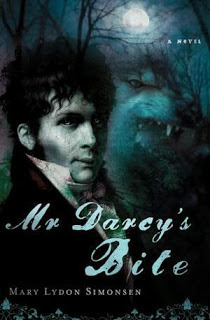 It’s October! Halloween is just around the corner. To celebrate the arrival of fall, Sourcebooks has reduced the price of the e-book for
Mr. Darcy’s Bite
to $2.99 (regularly $9.68). This is a savings of $6.69!
It’s October! Halloween is just around the corner. To celebrate the arrival of fall, Sourcebooks has reduced the price of the e-book for
Mr. Darcy’s Bite
to $2.99 (regularly $9.68). This is a savings of $6.69!Mr. Darcy’s Bite is one of my favorite books. It is not your usual werewolf story (and definitely not your usual D&E story), but a tale of love and acceptance. I have gotten some good reviews for the novel, but one of my favorites is from my hometown newspaper, The Newark Start Ledger:
This book is written with enough originality, whimsy and respect for Jane Austen’s style to make it stand out in the crowded field of Austen genre mash-ups. Simonsen revisits Darcy and Elizabeth’s tempestuous courtship and provides an explanation for Darcy’s erratic behavior: He’s a werewolf. Bitten on a childhood sojourn in Europe, Darcy has guarded his secret: He transforms at the full moon.
Because Simonsen carefully imagines how a werewolf nobleman would adapt to society and how that would play out with Austen’s characters, the story works as earnest rather than camp. After Darcy reveals his nature to Elizabeth, she must decide whether she still loves him. Simonsen’s characterizations are faithful to Austen, but engagingly playful with the possibilities of a werewolf double-life. His werewolf nature connects Darcy to the passions of the natural world, letting Simonsen ratchet up the couple’s romance. The classic love story between Elizabeth and Darcy holds firm, even if things do get a little hairy once a month.
I’m so pleased by Sourcebooks’ promotion that I am going to write a series of vignettes that tie-in with Mr. Darcy's Bite. The first is in the post below. Enjoy!
If you haven’t read Mr. Darcy’s Bite , now is the time. It is available on Amazon and Nook.
Published on October 01, 2013 08:55
September 29, 2013
My First Fan Fiction Efforts
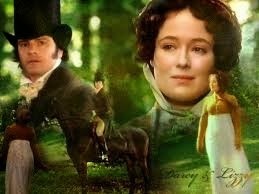 I was cleaning out old files on my computer and came across my very first efforts at writing Jane Austen fan fiction. (I thought they were long gone.) At the time I published,
Searching for Pemberley
, an historical novel, I didn’t even know fan fiction existed, but then I found meryton.com. Not knowing if I had any talent for writing fan fiction, I posted two short vignettes. The response was very encouraging. These vignettes became the seeds from which other stories would grow.Elizabeth Bennet RegretsThe morning after Mr. Darcy’s proposal, Elizabeth was able to leave Hunsford Lodge only after satisfying the Collinses that she was well enough to go on her morning walk alone. Charlotte had witnessed Mr. Darcy’s departure from the parsonage the previous afternoon. Despite her friend’s probing looks, Lizzy had said nothing about the gentleman’s visit and had kept to her room after dinner, complaining of a headache. In order to silence Mr. Collins and hasten her escape, Lizzy had mentioned that she wished to begin a study of Fordyce’s Sermons. Mr. Collins had presented the book to her earlier in the week when he had come upon her reading a novel, a book he considered inappropriate for an unmarried woman to be reading without the supervision and guidance of her father. He would have been horrified to learn that she had read Tom Jones and Tristram Shandy in the library at Longbourn without any supervision and at the recommendation of her father. Finally, after multiple assurances regarding her health, the weather, distances, etc., she had been allowed to leave the parsonage and immediately went in search of a place where she could reflect upon the events of the previous day.RosingsPark had beautiful vistas at every turn, but Lizzy’s favorite was where woods and pastureland met. The contrast of the dark greens of the forest and the lush bright greens of the pastures made it a favorite stop, and at this slice of Eden, the De Bourghs had placed stone benches paralleling the path—the perfect place for reflection. But she was not to be alone this morning as sitting on one of the benches was Mr. Darcy. It was too late to turn away, and so she pretended to be engrossed in her book providing him with an opportunity to pretend not to have noticed her. She soon realized that his being in this particular spot was no accident as on several occasions he had come across her at this very place. He quickly approached, and after asking her to do him the honor of reading his letter, he just as quickly departed.
I was cleaning out old files on my computer and came across my very first efforts at writing Jane Austen fan fiction. (I thought they were long gone.) At the time I published,
Searching for Pemberley
, an historical novel, I didn’t even know fan fiction existed, but then I found meryton.com. Not knowing if I had any talent for writing fan fiction, I posted two short vignettes. The response was very encouraging. These vignettes became the seeds from which other stories would grow.Elizabeth Bennet RegretsThe morning after Mr. Darcy’s proposal, Elizabeth was able to leave Hunsford Lodge only after satisfying the Collinses that she was well enough to go on her morning walk alone. Charlotte had witnessed Mr. Darcy’s departure from the parsonage the previous afternoon. Despite her friend’s probing looks, Lizzy had said nothing about the gentleman’s visit and had kept to her room after dinner, complaining of a headache. In order to silence Mr. Collins and hasten her escape, Lizzy had mentioned that she wished to begin a study of Fordyce’s Sermons. Mr. Collins had presented the book to her earlier in the week when he had come upon her reading a novel, a book he considered inappropriate for an unmarried woman to be reading without the supervision and guidance of her father. He would have been horrified to learn that she had read Tom Jones and Tristram Shandy in the library at Longbourn without any supervision and at the recommendation of her father. Finally, after multiple assurances regarding her health, the weather, distances, etc., she had been allowed to leave the parsonage and immediately went in search of a place where she could reflect upon the events of the previous day.RosingsPark had beautiful vistas at every turn, but Lizzy’s favorite was where woods and pastureland met. The contrast of the dark greens of the forest and the lush bright greens of the pastures made it a favorite stop, and at this slice of Eden, the De Bourghs had placed stone benches paralleling the path—the perfect place for reflection. But she was not to be alone this morning as sitting on one of the benches was Mr. Darcy. It was too late to turn away, and so she pretended to be engrossed in her book providing him with an opportunity to pretend not to have noticed her. She soon realized that his being in this particular spot was no accident as on several occasions he had come across her at this very place. He quickly approached, and after asking her to do him the honor of reading his letter, he just as quickly departed.I hope you enjoyed these short stories. Any comments? I’d love to hear them.P.S. My latest P&P re-imagining, When They Fall in Love , is now on sale for $2.99 at Nook and Amazon.
Published on September 29, 2013 00:01
August 29, 2013
Labor Day - Thank a Worker
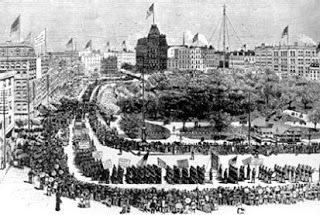 Labor Day Parade NYC 1882As a coal miner’s great granddaughter, and one who has researched just how bad (and dangerous) it was earning a living “down in the hole,” a mile below the surface, I consider Labor Day to be more than a reason to have picnics or for politicians to glad hand their constituents.* However, in appreciation of all those “who from rude nature have delved and carved all the grandeur we behold,”** I am prepared to enjoy a cold Guinness and to eat Polish sausage, macaroni salad, cole slaw, baked beans, etc.
Labor Day Parade NYC 1882As a coal miner’s great granddaughter, and one who has researched just how bad (and dangerous) it was earning a living “down in the hole,” a mile below the surface, I consider Labor Day to be more than a reason to have picnics or for politicians to glad hand their constituents.* However, in appreciation of all those “who from rude nature have delved and carved all the grandeur we behold,”** I am prepared to enjoy a cold Guinness and to eat Polish sausage, macaroni salad, cole slaw, baked beans, etc.A little history on the holiday from The Dept. of Labor website: "The first Labor Day holiday was celebrated on Tuesday, September 5, 1882, in New York City, in accordance with the plans of the Central Labor Union. The CLU urged similar organizations in other cities across the country to follow the example of New York and celebrate a “workingmen’s holiday” on that date. With the growth of labor organizations, the idea spread, and in 1885, Labor Day was celebrated in many industrial centers of the country.
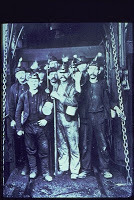 Coal Miners in the cage (elevator)By 1894, 23 states had adopted the holiday, and on June 28 of that year, Congress passed an act making the first Monday in September of each year a legal holiday in the District of Columbia and the territories.
Coal Miners in the cage (elevator)By 1894, 23 states had adopted the holiday, and on June 28 of that year, Congress passed an act making the first Monday in September of each year a legal holiday in the District of Columbia and the territories.So have an enjoyable weekend. Be careful driving, use sun screen, and watch the kiddies around the water.
*Two of my great grandfathers were killed in roof falls in the mines. A third died of pneumonia in his thirties, and the fourth broke is leg in a roof fall and developed emphysema. My grandfathers were both picking slate in the mines before they were twelve and were mule drivers in their teens. Fortunately, as adults, they found jobs above ground.
**That is a quote from Peter J. McGuire, general secretary of the Brotherhood of Carpenters and Joiners and a co-founder of the American Federation of Labor and one of two candidates for the founding of Labor Day. The other possibility is Matthew Maguire, later the secretary of Local 344 of the International Association of Machinists in Paterson, New Jersey. In 1882, he made his proposal while serving as secretary of the Central Labor Union in New York. Since I grew up in East Paterson, New Jersey, I’m voting for Matthew Maguire.
Published on August 29, 2013 14:47
August 15, 2013
Winner of A Death in Hampden
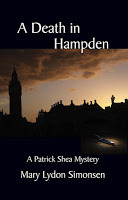 The winner of
A Death in Hampden
is Michelle Fidler. I will be e-mailing you shortly to get your e-mail information. If you do not hear from me in the next two days, please check your spam folder or e-mail me at quailcreekpub@hotmail.com.
The winner of
A Death in Hampden
is Michelle Fidler. I will be e-mailing you shortly to get your e-mail information. If you do not hear from me in the next two days, please check your spam folder or e-mail me at quailcreekpub@hotmail.com.Thank you to everyone who entered the giveaway and for sharing your comments and favorite mysteries.
Published on August 15, 2013 11:06
August 8, 2013
Launch and Giveaway of A Death in Hampden - a British Mystery by Mary Simonsen
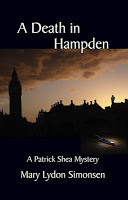 You may have noticed that I have changed the title of my blog from Austen-Inspired Fan Fiction to Fiction by Mary Simonsen. The reason is that I have published three mysteries in the Patrick Shea mystery series. To mark the change and to celebrate the publication of the third mystery,
A Death in Hampden
, I am giving away a paperback or e-book copy of my newest release. Here is a description of my latest effort:
You may have noticed that I have changed the title of my blog from Austen-Inspired Fan Fiction to Fiction by Mary Simonsen. The reason is that I have published three mysteries in the Patrick Shea mystery series. To mark the change and to celebrate the publication of the third mystery,
A Death in Hampden
, I am giving away a paperback or e-book copy of my newest release. Here is a description of my latest effort:When pop rock star, Derek Prince, is found dead in his London mansion, the case is assigned to Detective Chief Inspector Tommy Boyle and his sergeant, DS Patrick Shea, of New Scotland Yard. Although Prince's ex-girlfriend, Chloe Hastert, was found walking Hampden's High Street drenched in the singer's blood and carrying the knife that killed him, there is something about the case that doesn't sit right with DS Shea. With everyone believing Prince's killer is already in custody and with pressure from above to close the case, it falls to the two detectives to make sure they have got it right.
Also available are Three's A Crowd and A Killing in Kensington. If you are a fan of Law and Order UK, you will enjoy the Patrick Shea series.
The rules: The paperback is available for residents of the U.S. and Canada. The e-book is available to everyone. All you have to do is leave a comment WITH YOUR E-MAIL ADDRESS telling me who is your favorite mystery writer. A favorite title would also be appreciated as I enjoy reading books others have enjoyed. If you do not leave your e-mail address, I cannot contact you, and I will have to choose someone else. Please leave your comment by August 14th. The winner will be announced on August 15th.
A Death in Hampden is available on Kindle or in paperback on Amazon.
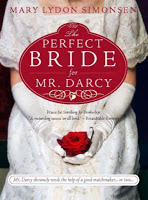
P.S. If you enjoy my Austen re-imaginings, I am giving away a copy of The Perfect Bride for Mr Darcy on Austen Authors.
Three's A Crowd - A novella introducing Detective Sergeant Patrick Shea
A Killing in Kensington - #2 in the Patrick Shea mystery series
Published on August 08, 2013 00:05
What readers are saying about The Second Date
I loved reading about the history of the families and how it was woven into the story. I felt right at home reading about Sonia and her family. It reminded me so much of my childhood growing up in the
I loved reading about the history of the families and how it was woven into the story. I felt right at home reading about Sonia and her family. It reminded me so much of my childhood growing up in the South and I found myself laughing out loud when reading about the one room no one was allowed to sit in with the plastic on the furniture and having to have a mediator at funerals. - C. Mason
Sonia Amundsen is a likable and feisty heroine, who is starting to think she isn't going to find her perfect man. It's not a predictable path to love and I really I loved the romance. The Second Date is an engaging picture of a close knit and vibrant group of friends and family in a community that has its share of fun, food, chaos and craziness. I found it a fascinating peek into the complexities and pressures of their lives and romances. It has depth and insight into the things in our pasts, our lives and families that make us who we are, with warmth, humour and realism. - Portia ...more
Sonia Amundsen is a likable and feisty heroine, who is starting to think she isn't going to find her perfect man. It's not a predictable path to love and I really I loved the romance. The Second Date is an engaging picture of a close knit and vibrant group of friends and family in a community that has its share of fun, food, chaos and craziness. I found it a fascinating peek into the complexities and pressures of their lives and romances. It has depth and insight into the things in our pasts, our lives and families that make us who we are, with warmth, humour and realism. - Portia ...more
- Mary Lydon Simonsen's profile
- 181 followers



